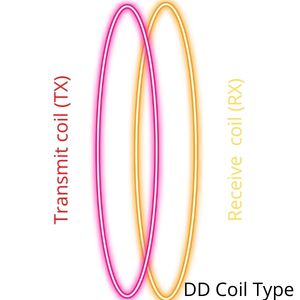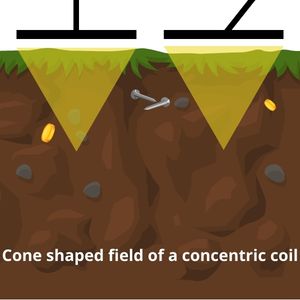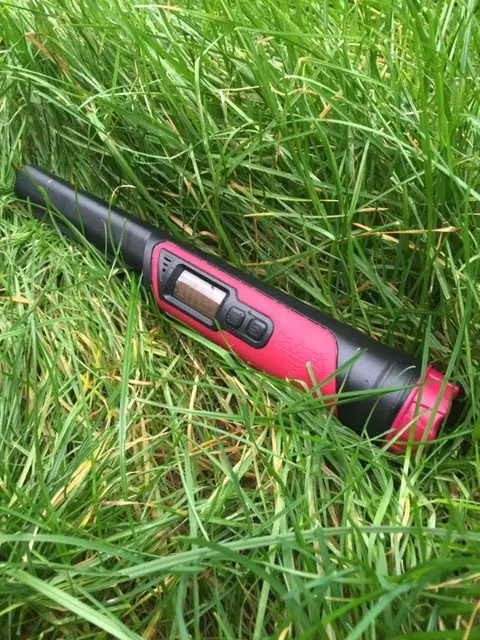Metal detector coils explained
Most, if not all metal detector search coils will be of a Concentric type or a Double D type. Search coil shapes can differ from being perfectly circular to being slightly elliptical or oval in shape but essentially work exactly the same, depending on their type.
The electromagnetic fields produced by these two coil types have different characteristics in the way they are shaped and way they operate penetrating the ground.
Metal detector coils
How does a metal detector work?

In a nutshell, a metal detector search coil consists of a tightly wound copper wire around two forming shapes to produce a “transmit” coil and a “receive” coil.
Maybe you remember from a school physics lesson, when you pass an electric current through a copper wire, it produces an electromagnetic field around it.
This is the basis for detecting a metallic object within that electromagnetic field. A metal detector when switched on and adjusted will produce what is known as a “balanced” electromagnetic field around the search coil. This is produced by the “transmit” coil.

When you sweep the search head over the ground and that balanced field passes over a metallic object, the transmit field “energises” the metallic object and causes it to disrupt the balanced field.
It’s this disruption that is picked up by the “receive” coil and gives you a signal through your headphones or built in speaker.
As different metals have different characteristics, they “energise” and disrupt the balanced field to varying degrees.
These differences, when subtracted from the balanced field, (along with some complicated maths) gives you your target information on your screen or via a specific tone pitch.
You can read further about this in my article about discrimination and metal conductivity here.
Metal detector coil frequency

The coil frequency along with the operating frequency of a metal detector is an important aspect to consider.
For a start, when thinking of a coil upgrade for an existing detector, you must be absolutely sure that the new coil is compatible with the detector.
Search coils are manufactured and tuned to operate at certain frequencies so attaching a search coil of a different frequency to the detector simply will not work.
Metal detector and coil frequencies work in different ways and have different effects on metals. Lower frequency detectors tend to find deeper targets as they punch deeper into the ground but are less sensitive to smaller, thinner targets and like bigger, thicker targets.

They also tend to take longer to process so slower sweeps are necessary. Higher frequency detectors tend to not punch as deep but are more sensitive to smaller, thinner targets.
They are less efficient with deeper, thicker targets. My above linked article goes into this further.
With the advancement of technology now, multi frequency detectors get over this deficiency by using several frequencies from low to high vastly reducing the chances of you missing anything.
This technology has almost rendered single frequency machines obsolete and typically, the Minelab Vanquish 340 Multi-IQ machine can be had for less than £250 nowadays. It also comes with a DD coil as standard.
You can read further my article on multi frequency machines here.

Unbeatable Multi Frequency!
You can now get the ultimate power of multi frequency technology over single frequency detectors with the Minelab Vanquish range of detectors.
The entry level Vanquish 340 now gives you ultimate depth, stability and sensitivity on all target types in every soil, including wet beach sand.
Best metal detecting coils
Metal detector coil design

So, most, if not all metal detector coils or search heads you’ll come across will be of a “Concentric” type arrangement or a “Double D” or “DD” type.
The concentric type will either be circular, elliptical or oval in shape but will essentially perform the same way.
The electromagnetic field produced around a concentric search will be “conical” shape. For want of a better description….like an ice cream cone or road cone pointing downwards.
This will mean that the deepest detection part of the search coil will be the centre. This has some implications that will have to be considered when detecting with a concentric coil type.
The first implication is that in order to maximise the chances of finding deeper targets, a much tighter overlapping sweep will be needed as the detection depth reduces as it gets closer to the edge of the coil.

Secondly, because of the cone shape of the electromagnetic field, there could be an increased chance of multiple, more shallow targets being detected together.
This can sometimes be confusing, not only for you, but for the detector also. It will try and give you target information for both targets which can cause target numbers to jump around.
When target numbers jump around, people tend to think it’s junk when there may be two perfectly good targets.
If these targets are made from different metals, they could also give you different tone pitches would could also add to the confusion.
There is also the possibility that a good target maybe close to some iron. In some cases, if you have your detector set to discriminate iron, you could also lose the good target. This is known in the detecting community as “target masking”.

This is when the detector will discriminate or “null out” the iron and not process or recover fast enough to start picking up targets again.
You will hear this as a machines “recovery” speed. This can be why concentric coils struggle on busy sites with a lot iron because they can mask the good targets in amongst it.
Finally, concentric coils can suffer from more noise in increasingly difficult soils.
This is again because of the cone shape picking up more volume of soil in its electromagnetic field. If you have a concentric coil on your detector, don’t be disheartened however.
They are perfectly good coils and will definitely find targets. They just have to be thought of differently.
Metal detector DD coil
Double D or “DD” coils operate slightly differently and have different characteristics. They essentially still have a transmit and a receive coil but their coil design overlaps the coils and creates a differently shaped electromagnetic field.

Instead of an upturned cone shape, we now have the shape of a blade which spans from the coils front tip to its back tip.
This now gives a DD coil some advantages over the concentric coil and is the logical progression when upgrading your detector or coil.
The shortcomings I have just listed with the concentric coil are now either eliminated or seriously reduced.
Unlike the concentric coil, it isn’t limited to its maximum depth being in the centre of the coil. You now get the full depth capability from the front of the coil to the back.
This now gives you the advantage of letting you reduce the tightness of your sweep pattern as you are covering more ground at maximum depth.
Secondly, because of the blade shape of the electromagnetic field, the chances of you detecting two targets under the blade are massively reduced. This gives you excellent “target separation”.
The increased target separation now makes for target identification better, either with screen information or tone ID because you are only picking up a single target.
You have more chance of getting a target “lock on”. This is the main reason why people use DD coils in busy, iron infested areas.
The types of hunting ground can be rich with finds because the iron demonstrates people have been there in the past. The DD coil will reduce any target masking and winkle out the good targets.
People also swap to much smaller DD coils in these types of areas to increase their chances again. Finally, DD coils perform much better in difficult soils because they pick up much less volume of soil so tend to be much quieter.
You can read my article on the upgrade NEL Tornado coil for the Garrett Ace 250 here.

Ultimate Tactical Packs!
Carry everything you’ll need for a detecting day like a First Aid kit, detector spares, finds boxes, batteries, snacks and drinks to rehydrate.
Never forget anything again with a belt pack!
Metal detector coil size
As a general rule, the bigger the coil, the deeper you’ll be able to detect. There are some things to consider however.
If you detect for long enough, you’ll come across people who will want to use the largest search coil they can find because they are paranoid about missing targets.
Detecting is 80% chance and it’s all about enjoying yourself when you go out. For a start, bigger coils can be much heavier and alter the balance of your machine making it nose heavy.
Just remember that you’ll have to swing this all day! Bigger coils, by their nature will also not be as sensitive as a smaller coil on smaller targets. They also can only be used really on open flat land.
They can be cumbersome when trying to negotiate through woodland paths or stubble fields for example.
Typically for a concentric coil, a twelve inch diameter coil will approximately give you 20% more depth than a stock eight inch coil.
Final thoughts
So, we’ve covered how a search coils works and the main differences between a concentric coil and a DD coil. These namely are the electromagnetic field shapes and the way they cover the ground and pick up targets in relation to their depth and proximity.
As a rule, larger coils are best used on more open and “quieter” areas to achieve greater depths. Smaller coils tend to be used on busier areas where target separation is needed.
Don’t forget that larger coils can be more noisy due to picking up more ground coverage.
Don’t forget, you can easily gain depth anyway by ensuring that you sweep as close to ground as possible and keeping your search coil flat to ground at the end of your swing.
If you have a ground balancing function, ensure you are ground balanced and turn up your sensitivity as much as you can but keep it from becoming unstable. Best of luck, stay safe and happy hunting!

The Evolution Pro Cut
The ultimate accessary for the serious metal detectorist. Super strong, stainless steel specially designed spade.
































